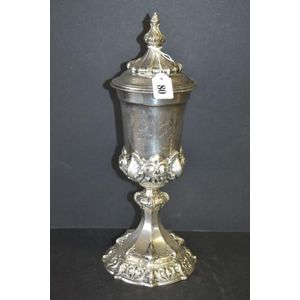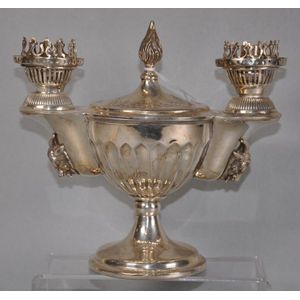Adapted Victorian Fuel Lamp with Goat Head Masks
You must be a subscriber, and be logged in to view price and dealer details.
Subscribe Now to view actual auction price for this item
When you subscribe, you have the option of setting the currency in which to display prices to $Au, $US, $NZ or Stg.
- Gilding - Gilding is a method of ornamentation whereby a thin sheet of gold metal is applied to items made of wood, leather, ceramics, glass and silver for decorative purposes.
For furniture including mirrors, the sheet of gold is usually applied over a coating of gesso. Gesso is a mixture of plaster of Paris and gypsum mixed with water and then applied to the carved wooden frames of mirrors and picture frames as a base for applying the gold leaf. After numerous coats of gesso have been applied, allowed to dry and then sanded a coat of "bole", a usually red coloured mixture of clay and glue is brushed on and allowed to dry, after which the gold leaf is applied. Over time parts of the gilding will rub off so the base colour can be seen. In water gilding, this was generally a blue colour, while in oil gilding, the under layer was often yellow. In Victorian times, gilders frequently used red as a pigment beneath the gold leaf.
Metal was often gilded by a process known as fire gilding. Gold mixed with mercury was applied and heated, causing the mercury to evaporate, the long-term effect of which was to kill or disable the craftsman or woman from mercury poisoning. The pursuit of beauty has claimed many victims, not the least of which were the artists who made those pieces so highly sought after today. - Britannia Metal / Epbm - Britannia metal items, often marked as "EPBM", are composed of a pewter type alloy of tin animony and copper, First produced in 1769, Britannia metal can be temporarily polished to a silver-like lustre. When electroplate was introduced in the mid 19th century, the Britannia newly manufactured Britannia metal items were oftern silver plated, but the plating wears off relatively quickly leaving an unappealing grey surface.
Britannia metal should not to be confused with Britannia standard silver, which is a higher grade of silver than sterling silver, containing at least 958 parts per thousand of pure silver, - Epbm / Britannia Metal - Britannia metal is a pewter type alloy, that can be temporarily polished to a silver-like lustre. In the 19th century, Britannia metal, was often electroplated. Plated wares in this metal may be marked EPBM (electro-plated Britannia metal). Where the silver plate wears on an EPBM item, the surface colour is dull grey, similar to pewter. Britannia metal was generally used as a cheaper alternative to electroplated nickel silver (EPNS) which is more durable. The primary component of nickel silver is copper and wear on an EPNS item will be indicated by a copper colored hue in the wear spots. EPBM items are held in low regard by collectors.
- Victorian Period - The Victorian period of furniture and decorative arts design covers the reign of Queen Victoria from 1837 to 1901. There was not one dominant style of furniture in the Victorian period. Designers used and modified many historical styles such as Gothic, Tudor, Elizabethan, English Rococo, Neoclassical and others, although use of some styles, such as English Rococo and Gothic tended to dominate the furniture manufacture of the period.
The Victorian period was preceded by the Regency and William IV periods, and followed by the Edwardian period, named for Edward VII (1841 ? 1910) who was King of the United Kingdom and the British Dominions and Emperor of India for the brief period from 1901 until his death in 1910.
This item has been included into following indexes:
Visually similar items

A German silver gilt cup and cover, 19th century, 26.5 cm high, 310 grams

German 800 grade silver lidded chalice with ecclesiastical decoration and Masonic inscriptions 1854/1875/1879, approx. 12 oz. troy

Sterling silver heavy gauge pedestal based grape vine embossed wine tasting cup with handle. London 1918

Royal Worcester vase & cover compressed circular body on pedestal foot, hand painted with highland cattle, signed H. Stinton, 27.5 cm high.
